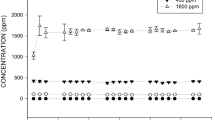Abstract
The uptake, distribution, and elimination of 3H-toluene in various tissues of rats were studied after inhalation or after gastric intubation.
The maximum radioactivity was measured 2–3 h after gastric intubation in tissues, except in white adipose tissue, where the peak radioactivity was reached at 5 h.
After inhalation exposure, the uptake to various tissues was very rapid. The maximum radioactivity in most tissues was reached in 15–30 min. The accumulation was slowest in white adipose tissue, where it took 1–2 h.
The radioactivity in tissues decreased after inhalation exposure more rapidly than after gastric intubation. Brown adipose tissue and white adipose tissue were different from other tissues in their ability to retain toluene. Twenty-four hours after exposures, only 1% or less of the initial radioactivity was found in tissues other than white adipose tissue, in which the corresponding value was 3.5–5%.
The results show a very rapid absorption and distribution of toluene after inhalation and a retention of radioactivity in white adipose tissue. After oral ingestion the distribution showed a similar but much slower pattern.
Zusammenfassung
Nach Inhalation und nach oraler Gabe wurden Aufnahme, Verteilung und Ausscheidung von 3H-Toluol in verschiedenen Geweben der Ratte untersucht.
Bei oraler Gabe (mittels Schlundsonde) wurde das Maximum an Radioaktivität im weißen Fettgewebe nach 5 Std erreicht, während es in allen anderen untersuchten Organen bereits nach 2–3 Std auftrat. Nach Inhalation wurde 3H-Toluol wesentlich schneller aufgenommen. Die höchste Radioaktivität wurde hierbei im weißen Fett nach 1–2 Std und in den meisten anderen Geweben nach 15–30 min gemessen. Ebenso war die Abnahme der Radioaktivität nach Inhalation schneller als nach oraler Gabe, wobei sich auch in diesem Fall das braune und das weiße Fettgewebe von anderen Organen unterschieden. Vierundzwanzig Stunden nach Applikation enthielt das Fett noch 3,5–5% der initialen Radioaktivität, während in allen anderen Geweben nur noch 1% oder weniger gemessen wurden.
Die Ergebnisse dieser Studie zeigen, daß Toluol nach Inhalation sehr viel rascher absorbiert und wieder ausgeschieden wird, als nach oraler Aufnahme, während das Verteilungsmuster nach beiden Applikationsarten sehr ähnlich ist.
Similar content being viewed by others
References
The American Conference of Governmental Industrial Hygienists. Threshold limit values 1966. In: Handbook of Laboratory Safety (N.V. Steere, ed.), p. 822. Cleveland: The Chemical Rubber Co. 1971
Dost, F. H.: Korrespondierende Flächen. In: Grundlagen der Pharmakokinetik, pp. 155–161. Stuttgart: Thieme 1968
Fiserova-Bergerova, V., Vlach, I., Singhal, K.: Simulation and prediction of uptake, distribution, and exhalation of organic solvents. Brit. J. industr. Med. 31, 45–52 (1974)
Gamberale, F., Hultengren, M.: Toluene exposure II. Psychophysiological functions. Wk-Environ.-Hlth 9, 131–139 (1972)
Greenburg, L., Mayers, M. R., Heimann, H., Moskowitz, S.: The effects of exposure to toluene in industry. J. Amer. med. Ass. 118, 573–578 (1942)
Laham, S.: Metabolism of industrial solvents. 1. The biotransformations of benzene and benzene substitutes. Occup. Hlth Rev. 21, 3–4 (1970)
Nomiyama, K., Nomiyama, H.: Respiratory elimination of organic solvents in man. Benzene, toluene, n-hexane, acetone, ethyl acetate and ethyl alcohol. Int. Arch. Arbeitsmed. 32, 85–91 (1974a)
Nomiyama, K., Nomiyama, H.: Respiratory retention, uptake and excretion of organic solvents in man. Benzene, toluene, n-hexane, trichloroethylene, acetone, ethyl acetate and ethyl alcohol. Int. Arch. Arbeitsmed. 32, 75–83 (1974b)
von Oettingen, W. F., Neal, P. A., Donahue, D. D.: The toxicity and potential dangers of toluene. J. Amer. med. Ass. 118, 579–584 (1942)
Press, E., Done, A. K.: Solvent sniffing. Physiologic effects and community control measures for intoxication from the intentional inhalation of organic solvents. I. Pediatrics 39, 451–461 (1967)
Taher, S. M., Anderson, R. J., McCartney, R., Popovtzer, M. M., Schrier, R. W.: Renal tubular acidosis associated with toluene sniffing. New Engl. J. Med. 290, 765–768 (1974)
Withey, R. J., Hall, J. W.: The joint toxic action of perchloroethylene with benzene or toluene in rats. Toxicology 4, 5–15 (1975)
Åstrand, I., Ehrner-Samuel, H., Kilbom, Å., Övrum, P.: Toluene exposure. I. Concentration in alveolar air and blood at rest and during exercise. Wk-Environ.-Hlth 9, 119–130 (1972)
Author information
Authors and Affiliations
Rights and permissions
About this article
Cite this article
Pyykkö, K., Tähti, H. & Vapaatalo, H. Toluene concentrations in various tissues of rats after inhalation and oral administration. Arch. Toxicol. 38, 169–176 (1977). https://doi.org/10.1007/BF00293651
Received:
Issue Date:
DOI: https://doi.org/10.1007/BF00293651




